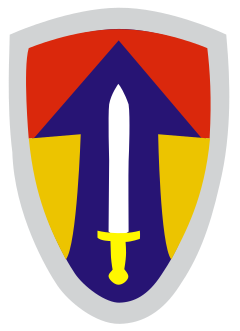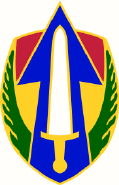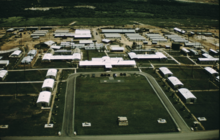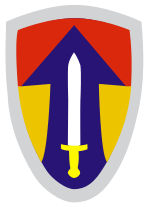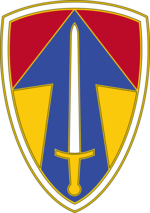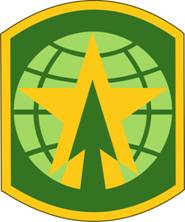
The 16th Military Police Brigade is a military police brigade of the United States Army headquartered at Fort Liberty, North Carolina. This brigade has the only airborne-qualified military police units in the U.S. Army, outside of the 82nd MP Company of the 82nd Airborne Division. It provides law enforcement and police duties to Fort Liberty, and for the XVIII Airborne Corps when deployed. As a brigade with organic airborne units, it is authorized a beret flash and parachute wing trimming, and the shoulder sleeve insignia was authorized to be worn with an airborne tab. According to U.S. Army's Institute of Heraldry, the shoulder sleeve insignia "was amended to delete the airborne tab effective 16 October 2008" when jump status of the brigade was terminated; however, various elements of the brigade remain on jump status.
The 49th Quartermaster Group was a United States Army Forces Command (FORSCOM) combat service support unit stationed at Fort Gregg-Adams, Virginia. The group motto was "Fueling the Force." Reactivated in 1993, the 49th held an inactivation ceremony at Fort Lee on 14 September 2012. Its subordinate 530th Support Battalion and 108th Quartermaster Company were reassigned to a brigade headquarters to await their own inactivation in September 2013. According to an article in the post newspaper, "The 54th and 111th, the Army's only active duty mortuary affairs units, are not likely to be inactivated but may be transferred. If any of the units remain at Fort Lee, they may be realigned under battalions either at Fort Eustis, home of the 7th Sustainment Brigade, or Fort Bragg, N.C., home of the XVIII Airborne Corps, the 49th's current higher headquarters."

The 87th Infantry Regiment is an infantry regiment in the United States Army. The regiment's 1st and 2nd Battalions are light infantry units assigned to the 1st and 2nd Brigade Combat Teams respectively of the 10th Mountain Division located at Fort Drum, New York. The 3rd Battalion was active in the U.S. Army Reserve in Colorado. The 4th Battalion was a Regular Army unit assigned to the 3rd Brigade Combat Team of the 25th Infantry Division (Light) at Schofield Barracks, Hawaii.
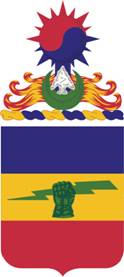
The 73rd Cavalry Regiment is a Cavalry Regiment in the United States Army, first formed in 1941. The three squadrons of the 73rd Cavalry Regiment provide reconnaissance, surveillance, and target acquisition (RSTA) to the Brigade Combat Teams of the 82nd Airborne Division. 3rd Squadron is assigned to 1st Brigade, 1st Squadron is assigned to 2nd Brigade, and 5th Squadron is assigned to 3rd Brigade.
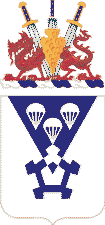
The 2nd Battalion, 503rd Infantry Regiment is an active duty airborne infantry battalion in the United States Army, assigned to the 173rd Airborne Brigade Combat Team and stationed at Caserma Del Din, Vicenza, Italy. The battalion has served with the 2nd Infantry Division, the 11th Airborne Division, the 24th Infantry Division, The 25th Infantry Division, the 82nd Airborne Division, the 101st Airborne Division, and the 173rd Airborne Brigade; has been stationed in Korea, Germany, Italy and the United States; and earned campaign credits in World War II, the Vietnam War, Operation Enduring Freedom—Afghanistan, and Operation Iraqi Freedom.

The 319th Field Artillery Regiment, more commonly referred to as the 319th Airborne Field Artillery Regiment, is a parent regiment in the U.S. Army Regimental System. Four battalions of the regiment are currently active. The first three battalions 1st Battalion, 319th Field Artillery Regiment, 2nd Battalion, 319th Field Artillery Regiment, 3rd Battalion, 319th Field Artillery Regiment are in the 82nd Airborne Division and the 4th Battalion, 319th Field Artillery Regiment is in the 173rd Airborne Brigade.
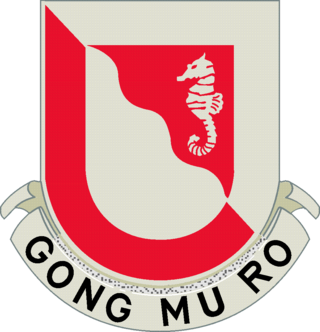
The 14th Brigade Engineer Battalion is a Combat Engineer Battalion of the United States Army based at Joint Base Lewis-McChord, Washington. The battalion is a subordinate unit of the 2nd Stryker Brigade, 2nd Infantry Division, and I Corps. The battalion's official motto is "Gong Mu Ro" and battle cry "Rugged!".

The 6th Field Artillery Regiment is a Field Artillery Branch regiment of the United States Army first activated in 1907 from numbered companies of artillery. It was first organized with two battalions.
The 8th Field Artillery Regiment is a field artillery regiment of the United States Army first formed in 1916. The regiment served in World War I, World War II, and Korea, and regimental units have served in Vietnam, Honduras, Panama, Operation Desert Storm, Operation Enduring Freedom and Operation Iraqi Freedom. Currently organized as a parent regiment under the U.S. Army Regimental System, the regiment's only active component is the 2nd Battalion, 8th Field Artillery Regiment, currently assigned to the 1st Infantry Brigade Combat Team, 11th Airborne Division and stationed at Fort Wainwright, Alaska.

The 15th Field Artillery Regiment (FAR) is a field artillery regiment of the United States Army first formed in 1916. A parent regiment under the U.S. Army Regimental System, the 15th FAR currently has two active battalions: the 1st Battalion, 15th Field Artillery Regiment, is assigned to the 1st Brigade Combat Team, 2nd Infantry Division, while the 2nd Battalion, 15th Field Artillery Regiment, is assigned to the 2nd Brigade Combat Team, 10th Mountain Division.
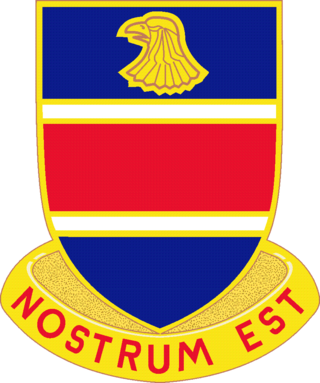
The 326th Engineer Battalion (Sapper Eagles) is one of three air assault engineer battalions in the United States Army. The 326th is part of the 1st Infantry Brigade Combat Team ("Bastogne")(♣), 101st Airborne Division and has been a part of the 101st since World War I.

The 32nd Field Artillery Regiment is a distinguished and highly decorated field artillery regiment of the United States Army, first Constituted in 1918.
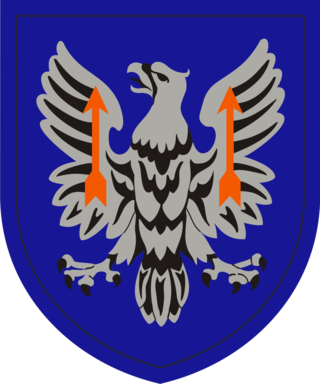
The 11th Expeditionary Combat Aviation Brigade is a Combat Aviation Brigade in the United States Army Reserve. The unit's lineage can be traced to the prior lineage and insignia of the 11th Aviation Group which was last headquartered in Illesheim, Germany in 2005. It is one of two aviation brigades of Army Reserve Aviation Command. The brigade consists of a headquarters company, two Black Hawk assault battalions, and one fixed wing battalion. The brigade was activated in its current formation on 16 September 2016.

The 58th Infantry Regiment is a regiment of the United States Army first established in 1917.

The 326th Medical Battalion was a divisional support medical unit of the United States Army. It supported the 101st Airborne Division, located at Fort Campbell, Kentucky. Its lineage and honors are perpetuated by the 626th Support Battalion, 101st Airborne Division, Fort Campbell, Kentucky.

The 1st Battalion, 321st Field Artillery Regiment is an inactive field artillery battalion of the United States Army. The battalion served in World War I, World War II, Vietnam and the Global War on Terror with the 82nd Airborne and 101st Airborne Divisions, and with the 18th Field Artillery Brigade. The battalion was officially inactivated in March 2014, and its firing batteries were distributed throughout the 82nd Airborne Division.

The 101st Airborne Division Artillery (DIVARTY) is the force fires headquarters for the 101st Airborne Division at Fort Campbell, Kentucky. The DIVARTY has served with the division in World War II, Vietnam, Operations Desert Shield and Storm, Operation Iraqi Freedom, and in peacetime at Camp Breckinridge and Fort Campbell, Kentucky, and Fort Jackson, South Carolina. The DIVARTY was inactivated in 2005 as part of transformation to modular brigade combat teams, but was reactivated on 16 October 2014 to provide fire support coordination and mission command for the training and readiness of field artillery units across the division.

The 2nd Battalion, 320th Field Artillery Regiment is an inactive field artillery battalion of the United States Army. The battalion has been assigned to the 82nd Airborne Division, 11th Airborne Division and 101st Airborne Division. The battalion has participated in World War I, World War II, Vietnam, Operation Desert Storm, Operation Iraqi Freedom, and Operation Enduring Freedom. The battalion deactivated in July 2015 as part of ongoing force reductions, and its personnel and equipment were reflagged as the 2nd Battalion, 32nd Field Artillery Regiment.

The 1st Battalion, 503rd Infantry Regiment is an active duty airborne infantry battalion in the United States Army, assigned to the 173rd Airborne Brigade Combat Team and stationed in Vicenza, Italy. The battalion has served with the 2nd Infantry Division, the 11th Airborne Division, the 24th Infantry Division, the 82nd Airborne Division, and the 173rd Airborne Brigade; has been stationed in Korea, Italy and the United States; and earned campaign credits in World War II, the Vietnam War, Operation Enduring Freedom-Afghanistan, and Operation Iraqi Freedom.

The United States Army Medical Command, Vietnam (USAMEDCOMV) provided Echelon/Role 3 Health Service Support to units of the United States Army, Vietnam (USAV). It was a Table of Distribution and Allowances organization created by consolidating the staffs of the 44th Medical Brigade and the USAV Surgeon's Office. This action was taken as part of the overall drawdown of forces in Vietnam in an effort to reduce headquarters staffs and increase efficiencies. As the medical footprint further reduced in 1972, it was replaced by the United States Army Health Services Group, Vietnam on 30 April 1972.
